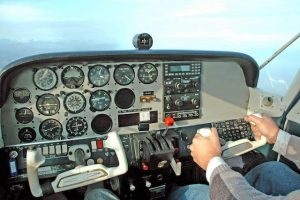Jet Orientation Course (JOC) Meets The Regulatory Requirements For Pilots
 In the realm of aviation, ensuring that pilots are adequately trained and proficient is paramount for maintaining the highest standards of safety and operational efficiency. One of the crucial steps in achieving this goal is the completion of the Jet Orientation Course (JOC). This specialized training program is designed to prepare pilots for the complexities of operating jet aircraft, bridging the gap between basic flight training and type rating certification. A key aspect of the JOC is its role in ensuring that pilots meet regulatory requirements for training and proficiency, which are essential for maintaining their licenses and certifications. This article explores the importance of the JOC in the context of regulatory compliance, highlighting how it enhances pilot qualifications and contributes to overall aviation safety.
In the realm of aviation, ensuring that pilots are adequately trained and proficient is paramount for maintaining the highest standards of safety and operational efficiency. One of the crucial steps in achieving this goal is the completion of the Jet Orientation Course (JOC). This specialized training program is designed to prepare pilots for the complexities of operating jet aircraft, bridging the gap between basic flight training and type rating certification. A key aspect of the JOC is its role in ensuring that pilots meet regulatory requirements for training and proficiency, which are essential for maintaining their licenses and certifications. This article explores the importance of the JOC in the context of regulatory compliance, highlighting how it enhances pilot qualifications and contributes to overall aviation safety.
Jet Orientation Course (JOC)
The Jet Orientation course is an advanced training program aimed at equipping pilots with the knowledge and skills necessary to operate jet aircraft effectively. It covers various aspects of jet operations, including high-speed aerodynamics, jet performance, flight control systems, and crew resource management (CRM). By providing a comprehensive understanding of these topics, the JOC prepares pilots for the demanding environment of commercial jet aviation.
Regulatory requirements for pilot training
Regulatory authorities such as the Federal Aviation Administration (FAA) in the United States and the European Union Aviation Safety Agency (EASA) in Europe establish stringent requirements for pilot training and proficiency. These regulations are designed to ensure that pilots possess the necessary skills and knowledge to operate aircraft safely. Key regulatory requirements include:
- Initial training: Pilots must undergo initial training that covers fundamental flying skills and knowledge.
- Type rating: To operate specific aircraft models, pilots must complete type rating training, which involves detailed instruction on the aircraft’s systems and procedures.
- Recurrent training: Pilots are required to undergo periodic recurrent training to maintain their proficiency and stay updated on the latest operational procedures.
- Proficiency checks: Regular proficiency checks are conducted to assess pilots’ skills and knowledge, ensuring they meet the required standards.
- Emergency procedures training: Pilots must be trained to handle various emergency situations effectively.
Role of JOC in meeting regulatory requirements
The Jet Orientation Course plays a critical role in ensuring that pilots meet these regulatory requirements. Here’s how the JOC contributes to regulatory compliance:
1) Comprehensive training in jet operations
The JOC provides comprehensive training in jet operations, covering topics that are essential for meeting regulatory standards. This includes:
-
- High-speed aerodynamics: Understanding the aerodynamic principles specific to jet aircraft, such as transonic and supersonic flight, is crucial for safe operation.
- Jet performance: Pilots learn about the performance characteristics of jet aircraft, including climb and descent profiles, fuel efficiency, and thrust management.
- Flight control systems: The JOC familiarises pilots with advanced flight control systems, including fly-by-wire technology and hydraulic systems.
- CRM: Emphasising effective communication, teamwork, and decision-making in a multi-crew environment is a key component of the JOC, aligning with regulatory requirements for crew resource management training.
2) Bridging the Gap Between Basic Training and Type Rating
The transition from basic flight training to type rating training can be challenging. The JOC serves as an intermediate step, bridging this gap and ensuring that pilots are well-prepared for type rating courses. This preparation is essential for meeting the regulatory requirements for type rating certification, which involves detailed instruction on the specific aircraft model a pilot will be operating.
3) Enhancing pilot proficiency
Regulatory authorities require pilots to demonstrate a high level of proficiency in operating jet aircraft. The JOC enhances pilot proficiency by providing hands-on training in jet simulators, allowing pilots to practice and refine their skills in a controlled environment. This practical experience is invaluable for meeting proficiency standards set by regulatory bodies.
4) Ensuring emergency preparedness
Training in emergency procedures is a critical regulatory requirement. The JOC includes extensive training in handling various emergency situations, such as engine failures, hydraulic system malfunctions, and cabin depressurization. By preparing pilots for these scenarios, the JOC ensures that they are capable of responding effectively to emergencies, which is essential for regulatory compliance.
Benefits of JOC for regulatory compliance
Completing the Jet Orientation course offers several benefits that contribute to regulatory compliance and enhance a pilot’s qualifications:
1) Advanced knowledge and skills
The JOC equips pilots with advanced knowledge and skills that are essential for meeting regulatory requirements. This includes a deep understanding of jet aircraft systems, high-speed aerodynamics, and performance characteristics. Pilots who complete the JOC are better prepared to handle the complexities of jet operations, ensuring they meet the stringent standards set by regulatory authorities.
2) Increased confidence and competence
By providing comprehensive training in jet operations, the JOC boosts pilots’ confidence and competence. This increased proficiency is crucial for meeting regulatory requirements, as it ensures that pilots are capable of operating jet aircraft safely and efficiently. Confident and competent pilots are better equipped to pass proficiency checks and maintain their licenses and certifications.
3) Enhanced emergency response skills
The JOC’s focus on emergency procedures training ensures that pilots are well-prepared to handle a wide range of emergency situations. This preparedness is a key component of regulatory compliance, as it demonstrates that pilots possess the necessary skills to manage emergencies effectively. Enhanced emergency response skills contribute to overall aviation safety and help pilots meet regulatory standards.
4) Improved crew coordination
Crew resource management (CRM) training is a vital part of the JOC, emphasizing effective communication, teamwork, and decision-making in a multi-crew environment. Regulatory authorities require CRM training to ensure that pilots can work effectively with their crew members. By improving crew coordination, the JOC helps pilots meet these regulatory requirements, enhancing their qualifications and career prospects.
JOC as a pathway to type rating training
One of the primary purposes of the Jet Orientation Course is to prepare pilots for type rating training. Type rating certification is mandatory for operating specific models of jet aircraft, and the JOC serves as a crucial preparatory step in this process.
1) Building a strong foundation
JOC provides pilots with a solid foundation in jet aircraft operations, covering essential topics such as aerodynamics, performance, and flight control systems. This foundational knowledge is critical for the more specialized and detailed training that pilots receive during type rating courses. By building a strong foundation, the JOC ensures that pilots are well-prepared for the challenges of type rating training.
2) Smoothing the learning curve
Type rating training can be intense and demanding, requiring pilots to master complex systems and procedures specific to the aircraft model they will be operating. The JOC helps to smooth the learning curve by providing pilots with a thorough understanding of jet operations before they begin type rating training. This preparation makes it easier for pilots to grasp the detailed concepts and procedures covered in type rating courses.
3) Reducing training time and costs
Airlines invest significant resources in training their pilots. By completing the JOC, pilots are better prepared for type rating training, which can lead to reduced training time and costs for airlines. This efficiency is beneficial for both pilots and airlines, making the JOC a cost-effective step in the training process.
Career advancement and enhanced qualifications
Completing the Jet Orientation course not only ensures regulatory compliance but also enhances a pilot’s qualifications and career prospects. Here’s how the JOC impacts a pilot’s career trajectory:
1) Meeting industry standards
JOC ensures that pilots meet industry standards for training and proficiency, making them eligible for employment with commercial airlines. Airlines prefer candidates who have completed the JOC because it demonstrates their readiness for the complexities of jet operations. This industry-standard training enhances a pilot’s qualifications and increases their employability.
2) Competitive edge in the job market
In a competitive job market, having completed the JOC gives pilots a distinct advantage. Airlines prioritize candidates who have undergone this specialized training, recognizing the value of the skills and knowledge gained through the JOC. This competitive edge can be crucial in securing employment with reputable airlines and advancing one’s career.
3) Opportunities for career progression
Pilots who have completed the JOC are well-prepared for further professional development and career progression. The skills and knowledge acquired during the JOC are essential for advanced roles such as captain or training instructor. Completing the JOC demonstrates a pilot’s commitment to continuous improvement and readiness for increased responsibilities.
4) Global career prospects
JOC is recognized internationally, providing pilots with career opportunities across the globe. Airlines worldwide value the comprehensive training provided by the JOC, making it easier for pilots to secure positions with international carriers. This global recognition enhances a pilot’s career prospects and opens doors to diverse and rewarding opportunities.
Advance your career with JOC
The Jet Orientation Course (JOC) is an essential component of pilot training, ensuring that pilots meet regulatory requirements for training and proficiency. By providing comprehensive training in jet operations, the JOC prepares pilots for the complexities of commercial aviation and enhances their qualifications. The course covers critical topics such as high-speed aerodynamics, jet performance, flight control systems, and crew resource management, equipping pilots with the skills and knowledge necessary for safe and efficient jet operations.
Completing the JOC offers numerous benefits, including advanced technical knowledge, improved decision-making skills, enhanced crew coordination, and increased emergency preparedness. These attributes contribute to regulatory compliance and overall aviation safety. Additionally, the JOC serves as a crucial preparatory step for type rating training, ensuring that pilots are well-prepared for the detailed instruction and complex systems covered in type rating courses.
In terms of career advancement, the JOC provides pilots with a competitive edge in the job market, meeting industry standards and increasing their employability. It opens doors to entry-level positions with reputable airlines, opportunities for type rating sponsorship, and rapid career progression. The global recognition of the JOC further enhances a pilot’s career prospects, providing opportunities with international carriers and diverse career paths.
Jet Orientation course is not just a regulatory requirement. It is a pathway to a successful and fulfilling career in aviation. By investing in the JOC, pilots demonstrate their commitment to excellence and readiness for the challenges of modern aviation. The JOC ensures that pilots meet regulatory standards, maintain their licenses and certifications, and are well-equipped to operate jet aircraft safely and efficiently. As the aviation industry continues to evolve, the importance of the JOC will only grow, making it a critical step in the journey of every aspiring airline pilot.










